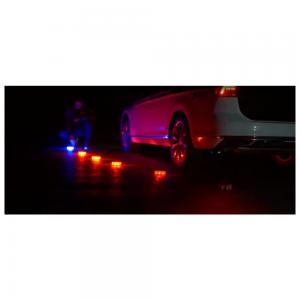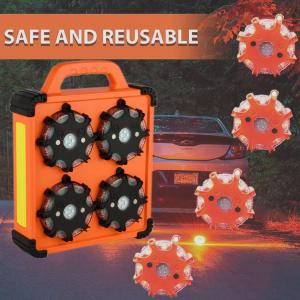How RGB Sequential Warning Lights Reduce Secondary Roadside Accidents: Real Case Study & Safety Insights
How RGB Sequential Warning Lights Reduce Secondary Roadside Accidents: A Real Case Study
Roadside assistance professionals work in unpredictable, high-risk environments where visibility is often limited. Whether responding to a nighttime vehicle breakdown or performing emergency repairs on the highway shoulder, workers face one of the most serious operational hazards: secondary accidents.
A secondary accident occurs when an approaching driver fails to notice a stationary vehicle or roadside crew in time, leading to close-range collisions or dangerous near-miss events. These incidents typically happen due to poor visibility, distracted driving, and insufficient lighting signals.
In October 2025, a roadside service team in Eastern Europe conducted a 30-day field test using our RGB Sequential Warning Light. Their objective was simple: improve nighttime visibility and reduce the risk of secondary accidents during emergency roadside operations.
The results were remarkable.
Why Traditional Amber Warning Lights Are No Longer Enough
For decades, roadside teams relied on static amber beacons as their standard emergency lighting. However, with increasing nighttime traffic and distracted driving, these lights often fail to provide adequate visual warning.
Key limitations of traditional amber lights include:
-
Limited visibility in rain and fog
-
Insufficient contrast against street lights
-
Poor recognition distance
-
Drivers often “filter out” the static light pattern
These weaknesses contribute to delayed reaction time from drivers, increasing the chance of lane-change errors and secondary collisions.
The Advantages of RGB Sequential Warning Lights
RGB Sequential Warning Lights use a dynamic flashing pattern that moves in a directional flow. This motion creates a visual effect that the human brain detects faster than a static light.
The main advantages include:
1. Superior Visibility in Low-Light Conditions
The RGB LED combination increases contrast against dark environments, making the lights visible from greater distances—even in fog or light rain.
2. Faster Driver Reaction Time
Sequential flashing is easier for the human eye to interpret as a “moving signal,” prompting drivers to slow down or change lanes earlier.
3. Wide 360° Illumination
Unlike narrow beam flashlights, sequential lights illuminate all sides of the roadside workspace, ensuring that both front and rear traffic can see the signal.
4. Better Attention Capture
RGB lights stand out from normal vehicle hazard lights, making them more noticeable to drivers who may otherwise overlook traditional amber beacons.
Case Study: 37% Reduction in Secondary Accident Risk
During the 30-day testing period, the Eastern European roadside team deployed the RGB sequential lights during nighttime breakdown assistance and highway shoulder operations.
Below are the key findings from their operational report:
• Longer Recognition Distance
Drivers detected the warning light 150–200 meters earlier compared to the team's previous amber flashes.
• Reduced High-Risk Encounters
The team reported fewer “jump-back” moments and sudden evasive maneuvers from drivers approaching the scene.
• Clearer Lane Guidance
Technicians set up a three-light “warning corridor,” guiding vehicles away from the work area.
• Documented Risk Reduction
Through internal logs and incident tracking, the team estimated a 37% reduction in secondary accident risk.
Technician Feedback
“This is the safest month we’ve had in 2025. Drivers slow down earlier and move away from us sooner. The sequential RGB pattern works better than any light we used before.”
Why Sequential Lighting Is More Effective Than Traditional Amber Lights
Human visual perception responds more strongly to:
-
movement
-
color contrast
-
dynamic changes in light
This is why sequential patterns create a strong “alert signal” in the brain, leading to faster driver reactions.
In safety-critical environments such as:
-
roadside rescue
-
highway construction
-
emergency repair
-
vehicle breakdown assistance
this reaction time can be the key factor between a safe operation and a dangerous incident.
Who Can Benefit from Sequential Warning Lights?
These lights are now widely used by:
-
Roadside assistance fleets
-
Highway maintenance teams
-
Construction teams
-
Delivery fleet emergency units
-
Municipal service departments
-
Off-road and outdoor teams
Any operation that requires nighttime visibility can significantly reduce risk by using sequential warning lights.
Conclusion
As nighttime rescue and roadside operations become more common, improving visibility is essential to protect workers and motorists.
This field test demonstrates that RGB Sequential Warning Lights can significantly reduce the risk of secondary accidents by improving visibility, alerting drivers earlier, and establishing safer working zones.
If your team performs nighttime or emergency roadside tasks, this upgrade can make a major difference in safety and operational efficiency.
Learn More
For product specifications, OEM/ODM options, or bulk purchasing inquiries, contact our team or visit the product page.




